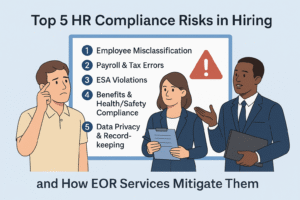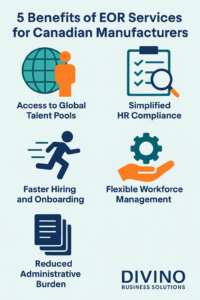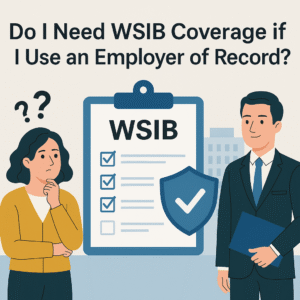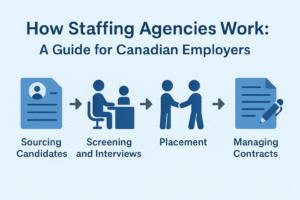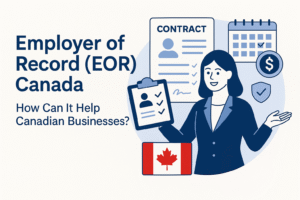Hiring the right person changes everything. The right teammate lifts projects, strengthens culture, protects margins, and wins customer loyalty. The wrong hire does the opposite—drags timelines, erodes morale, and quietly burns cash. If you’ve ever hired in a hurry or made a call you had to unwind later, you know the sting. You also know it’s avoidable.
In Canada—especially across Ontario’s competitive markets—smart employers are partnering with employment agencies to reduce risk and improve hiring outcomes. This article breaks down how employment agencies help companies avoid bad hires, why the typical mis-hire happens, and the practical steps that protect your team and bottom line. We’ll stay human, clear, and data-grounded, and we’ll end with a simple option if you’d rather not carry the recruiting load: leave your hiring to us and we’ll take it from there.
The real cost of a bad hire (and why it hurts more than you think)
Let’s start bluntly: a bad hire is expensive. It isn’t just salary paid to the wrong person. It’s the compounding effect of time, lost momentum, repeat recruiting, training, overtime for the team covering gaps, customer dissatisfaction, and opportunity costs while the seat isn’t producing.
Common ranges cited by HR and management research put the cost of a bad hire at ~30% of first-year earnings at minimum—and 1.5× to 3.5× salary for critical roles when you add replacement and productivity losses. Put another way: a $60,000 mis-hire can quietly morph into a $90,000–$210,000 mistake once you’re done re-hiring and stabilizing the team.
And the pain isn’t just dollars:
- Momentum loss: Projects slip; process debt accumulates.
- Team morale: Good people shoulder extra work and ask, “Why did we hire them?”
- Leadership attention: Hours you should spend on growth get spent on performance management and do-overs.
- Brand risk: Shaky delivery and inconsistent customer experiences chip away at reputation.
Avoiding bad hires isn’t perfectionism—it’s good operations hygiene. The question is how.
Why bad hires happen (even to disciplined teams)
Even strong teams fall into predictable traps:
- Rushing under pressure
Vacancies stretch people thin. The instinct is to “get someone in.” Rushing compresses sourcing, weakens screening, and turns interviews into quick chats. Speed without structure equals dice rolls. - Unclear role definition
If success isn’t clearly defined—skills, outcomes, behaviours—interviews become subjective and job postings attract the wrong people. Vague in = vague out. - Unstructured interviews
Free-form interviews feel natural but aren’t very predictive. Without consistent job-related questions and scoring, we overweight charisma and underweight competence. - Under-vetting and over-trusting resumes
Skills go untested. References get phoned in or skipped. Credentials aren’t verified. It’s easy to be impressed by a CV and miss reality checks. - Culture misfit
The person can do the tasks, but their operating style clashes with how your team actually wins—pace, communication, accountability, safety, or customer tone. - Shallow candidate pools
If you only see who applies to a single posting, you limit quality. With a thin slate, you end up choosing the “least wrong,” not the right.
These aren’t moral failings—they’re bandwidth and process problems. They’re also exactly where a strong agency partner changes the game.
Eight ways employment agencies help companies avoid bad hires
1) They start by clarifying success (so you hire to outcomes, not guesswork)
A good agency won’t just “take a job order.” They’ll workshop the role with you:
- What will this person deliver in 90/180/365 days?
- Which must-have skills matter vs. nice-to-haves?
- What behaviours show up in your best performers?
- What constraints (shift, site, safety, tools, bilingual needs, travel) really exist?
This alignment sharpens sourcing, focuses interviews, and prevents the classic mismatch where someone is hired for a generic description but judged on outcomes that were never stated. It also yields a cleaner, more accurate job post—attracting better candidates and filtering out noise.
2) They expand your reach (especially to passive, high-quality talent)
Top talent often isn’t browsing job boards. Agencies cultivate ongoing pipelines—pre-screened candidates they speak with weekly, referrals from prior placements, and passive candidates open to a tap on the shoulder. Because they recruit year-round across many employers, they see more signal: who’s reliable, who’s trending up, who’s ready for their next challenge.
For you, this means stronger shortlists faster. Instead of spending weeks collecting resumes, you review targeted options—people who match the brief, have been spoken with, and can actually do the job.
3) They run multi-layer screening (to catch what casual processes miss)
Agencies live or die by the quality of their vetting. Expect:
- Structured pre-screens: Consistent, role-specific questions scored against the brief.
- Skills verification: Work samples, practical tests, software assessments, trade checks—evidence, not just claims.
- Credential & background verification: Employment history, education, licenses/certifications, and (where appropriate) background or criminal checks.
- Reference calls that matter: Not “Would you rehire them?” but “Tell me about a deadline they nearly missed—what did they do?”
- Culture & safety alignment: For Ontario employers, safety, regulatory awareness, and site readiness truly matter. Agencies look for behaviours that align with your environment.
The result: fewer surprises. If a candidate can’t demonstrate skills, if stories don’t line up, or if references hesitate, they don’t reach your interview table.
4) They bring industry specialization (so the right questions get asked)
General interviews miss domain nuance. Specialist recruiters know how to probe:
- For skilled trades, they validate tickets, tool familiarity, blueprint reading, tolerances, lock-out/tag-out practices, safety mindset.
- For office/admin, they test systems fluency (e.g., ERP, Excel), accuracy, throughput, and customer tone.
- For tech, they assess problem-solving, code quality, debugging approach, and collaborative behaviours.
- For healthcare, they check patient-safety orientation, communication, and documentation fidelity.
Specialization reduces false positives (great talkers who can’t deliver) and false negatives (quiet high-performers overlooked by generalists).
5) They compress time-to-hire (without cutting corners)
Bad hires often happen when teams are exhausted—vacancy drag pressures a quick decision. Agencies fight that pressure by moving the front end fast and methodically:
- Ready candidate pools → shortlists in days, not weeks
- Parallelized tasks → references, testing, and scheduling happen together
- Coordinated calendars → batch your interviews and triage quickly
Filling faster has two protective effects: you retain top candidates (they don’t accept elsewhere) and you avoid settling because the team is overworked.
6) They reduce turnover risk (including try-before-you-hire paths)
Two powerful risk-reducers:
- Culture-aware matching: Agencies evaluate how someone gets things done, not just what they know. Pace, feedback style, safety approach, attitude toward ambiguity—these small details forecast retention.
- Temp-to-hire: For roles where fit is crucial, a trial period lets both sides validate reality. If it clicks, convert. If not, you pivot—without a full separation cycle.
Some agencies also include placement guarantees for permanent hires—if a new hire exits inside a set window, they’ll replace at no additional fee. That’s real risk-sharing.
7) They improve your candidate experience (which lands your first choice)
Top candidates judge you by your process. Agencies serve as a courteous, responsive point of contact—fast feedback, clear next steps, honest expectations. That professional experience translates into higher offer acceptance and stronger reputation. When you consistently land your A-choice, you avoid the downstream risk of hiring your B- or C-choice just to fill a seat.
8) They free your leaders to lead (and bring consistency you can’t lose)
Finally, there’s the practical truth: hiring is a process business. Agencies execute the same playbook every week, at scale. That consistency means fewer misses and less variance between hires. Meanwhile, your leaders stay focused on operations and growth instead of drowning in resumes and scheduling.
A practical toolkit: the “no-bad-hire” checklist
Whether you partner with an agency or not, this compact checklist helps you avoid common traps:
- Define success first: Outcomes, must-haves, constraints. Write the rubric before you post.
- Broaden sourcing: Post on relevant boards, leverage referrals, and reach passive talent (directly or via a recruiter).
- Structure interviews: Same core questions for all, scored. Add a work sample or test wherever possible.
- Verify everything: Credentials, employment, references. Dig into behaviours and outcomes.
- Assess culture & safety: How do they handle feedback? How do they prioritize quality and safety?
- Decide fast, not loose: Compress the process into days—not months—so you choose from your best slate.
- Use trial paths when fit matters: Temp-to-hire or contract phases reduce risk.
- Onboard intentionally: First 90 days define trajectory—clarify expectations, coach early, inspect outcomes.
This is exactly the structure an agency brings to you day one.
Results you can expect when you tighten hiring
When Canadian employers adopt the playbook above—often with an agency’s help—the outcomes are consistent:
- Fewer mis-hires: Better signal in → better choices out.
- Faster fills: Vacancy drag shrinks, and your team stops bleeding time.
- Higher retention: People who fit the work and culture stay.
- Better productivity: New hires produce earlier; managers spend less time “managing around” issues.
- Lower total cost: Even if you pay a placement fee, the ROI is positive when you avoid a $20–200k mistake and months of churn.
If you’re tired of recruiting roulette, there’s a calmer way to hire.
How Divino Business Solutions helps Canadian employers avoid bad hires
We built Divino around a simple promise: hire better, faster, and safer—without adding weight to your workload. Here’s how we deliver:
- Ontario-aware role design: We help you clarify outcomes, compliance needs, and site realities before we ever post.
- Deep local pipelines: Across office, light industrial, logistics, skilled trades, healthcare support, and tech support roles, we maintain ready, pre-screened candidates who want to work in your city, on your shift, at your pace.
- Structured vetting: Behavioural screens, skills checks relevant to the job, credential and reference verification, and safety/culture alignment.
- Shortlists in days: We compress time-to-hire while raising quality, so you don’t have to choose between speed and standards.
- Temp, temp-to-hire, or direct hire: You choose the risk/velocity tradeoff; we execute.
- Post-placement check-ins: Early touchpoints with you and the new hire to ensure lift-off.
- Straightforward guarantees: If a rare mismatch happens on a direct hire, we make it right—fast.
Bottom line: we carry the recruiting load so you can focus on operations, knowing your next teammate is screened to deliver.
Prefer not to juggle job ads, screening calls, and reference checks this month?
Leave your hiring to us and we’ll take it from there.
FAQs (excluded from word count)
Q1: What exactly counts as a “bad hire”?
A bad hire is someone who, despite best intentions, doesn’t meet the role’s requirements or fit the culture to the point that the business, the team, or the employee can’t succeed together. Common signs: missed deliverables, quality issues, safety concerns, friction with team norms, or customer complaints—especially after clear feedback and support.
Q2: How can we spot warning signs earlier?
Use work samples/tests, structured interview questions tied to outcomes, behavioural probes (“tell me about a time…”), and real reference calls. If answers are vague, credentials don’t verify, or references hesitate, slow down—there’s usually a reason.
Q3: Is using an agency worth it for small businesses?
If a mis-hire would be painful (time, money, customer impact), the math usually favours an agency. You trade a transparent fee for speed, better candidates, a tighter process, and often a guarantee—versus the cost of doing it twice.
Q4: Can agencies help with permanent hires, not just temps?
Yes. Quality firms recruit for temp, temp-to-hire, and direct (permanent) roles. For high-impact seats, direct hire with a guarantee or temp-to-hire validation provides strong risk control.
Q5: What should we prepare before engaging an agency?
Define success (90/180/365-day outcomes), must-have skills, constraints (shift/site), compensation range, interviewers, and a target timeline. The clearer the brief, the better (and faster) the results.
Q6: How quickly can an agency present candidates?
For common roles: often within 2–5 business days because pipelines exist. For specialized roles: allow more time for targeted search and assessment—but still typically faster (and more reliable) than going it alone.
References (citations & URLs only—no links appear above)
- U.S. Department of Labor estimate on cost of a bad hire (approx. 30% of first-year earnings).
https://blog.dol.gov - SHRM research and articles on the costs of turnover and bad hires.
https://www.shrm.org/resourcesandtools/hr-topics/talent-acquisition - Harvard Business Review insights on interview structure and hiring accuracy.
https://hbr.org/2016/04/your-approach-to-hiring-is-all-wrong - CareerBuilder survey: percentage of employers who made a bad hire; average reported cost.
https://press.careerbuilder.com - Robert Half reports on hiring mistakes and their impacts (manager surveys).
https://www.roberthalf.ca/en/research - Gallup reporting on disengagement and productivity costs.
https://www.gallup.com/workplace/349484/state-of-the-global-workplace.aspx - Tony Hsieh (Zappos) interviews referencing cumulative costs of bad hires.
https://www.businessinsider.com/tony-hsieh-bad-hires-cost-2010-5 - Ontario employer compliance and safety expectations (context for screening, site readiness).
https://www.ontario.ca/page/employment-ontario - Sandvine / Global Internet Phenomena (context on speed-to-hire and competition environment—supportive trend data).
https://www.sandvine.com/blog - Canadian HR Reporter coverage of hiring challenges and turnover impacts.
https://www.hrreporter.com
